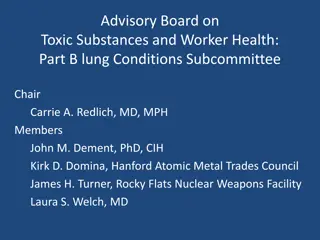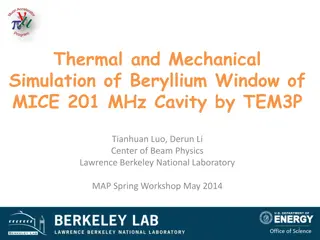Organometallic Compounds of Group 2 Elements
In the realm of organometallic chemistry, Group 2 elements, specifically alkaline earth metals like beryllium and magnesium, exhibit intriguing properties and reactivities. The chemistry of these elements, mimicking that of Group 12 elements in many aspects, leads to the formation of various organom
5 views • 27 slides
Investigating Be Dust Generation for Fusion Reactors
Investigate the properties of beryllium (Be) dust particles generated using milling techniques for fusion reactors. The study involves analyzing particle size, morphology, crystal orientation, and thermal behavior of Be dust in air and water environments. Laboratory experiments will be conducted to
2 views • 5 slides
Exploring the Fascinating World of Elements
Dive into the intriguing characteristics of different elements, from the peculiarities of Hydrogen to the inert nature of Helium, the reactivity of Lithium and Beryllium, the uniqueness of Boron, and the importance of Carbon in organic chemistry. Discover their properties, electron configurations, a
0 views • 62 slides
Update on Lung Conditions Subcommittee of Advisory Board on Toxic Substances and Worker Health
The Lung Conditions Subcommittee conducted a review of 80 Part B cases related to various respiratory conditions in workers. The review highlighted common reasons for incorrect adjudications, such as misapplications of presumption criteria and unclear decisions on beryllium exposure. Conclusions rev
0 views • 21 slides
Progress Report of Part B Lung Conditions Subcommittee
Progress report detailing the activities of the Part B Lung Conditions Subcommittee from initial advisory board meetings to defining data needs, reviewing data analysis, and addressing questions and comments from the Department of Labor related to lung conditions including Chronic Beryllium Disease
0 views • 18 slides
Thermal and Mechanical Simulation of Beryllium Window for MICE 201 MHz Cavity
Conducted thermal and mechanical simulations using TEM3P for the beryllium window of the MICE 201 MHz cavity. Analysis focused on temperature distribution, frequency shifts, thermal deformation control, and stress considerations under varying operation conditions and material properties. Detailed in
0 views • 11 slides
Production and Measurement of Beryllium-10 in Quartz
Beryllium-10 (10Be) is produced through cosmic ray spallation and muon-reduced reactions, with production rates influenced by factors like altitude and latitude. Measurement involves accelerated mass spectrometry on pure quartz samples, where the ratio of 10Be/9Be is determined relative to a standar
0 views • 12 slides






